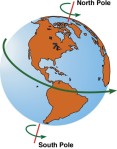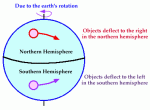Astronomers use coordinate systems to plot the position of stars in the night sky
Astronomy questions and answers – Looking up into the night sky you probably wonder how ancient stargazers were able to navigate using the stars in the night sky as their guide. One of the first things ancient stargazers did to help them navigate the night sky and the surface of the Earth was to create a coordinate system to pinpoint relative positions of the stars in the night sky in relation to one another.
Looking upward into the night sky, imagine the sky above you as a sphere of infinite size, centered on the Earth. This technique works in general because distances to the stars above you is not discernible using your naked eye, so the objects you see above you in the night sky all appear to lie on a great sphere at an infinite distance in relation to you.
Modern astronomers use two coordinate systems to determine the relative positions of objects in the night sky; the altitude-azimuth coordinate system and the equatorial coordinate system. We will talk a little about both coordinate systems currently being used by modern astronomers to help them plot the positions of the objects they view in the night sky and using celestial objects you view on your “Journey to the Beginning of Space and Time” to navigate your way through the universe.

In the altitude-azimuth coordinate system, altitude indicates the number of degrees from the horizon to the object in the night sky you’re viewing and ranges from 0 degrees at the horizon to 90 degrees at the zenith above you. Modern astronomers measure azimuth along the horizon from north to east, to the point where a line passing through the object in the night sky intersects the horizon at a right angle, and azimuth varies between 0 degrees and 360 degrees. Astronomers also subdivide each degree of azimuth into 60 arcminutes and each arcminute into 60 arcseconds, which helps to further subdivide the immense distances between each degree of measurement in the night sky.

The altitude-azimuth coordinate system doesn’t take into account the rotation of the Earth, though, and astronomers have solved this problem by fixing coordinates to the celestial sphere you imagine above you in the night sky. Celestial cartographers have created “celestial globes”, similar to the globes of the Earth that cartographers have devised for centuries to show the Earth and all of its features. On these celestial globes, you’ll find terms like the celestial equator and North and South celestial poles.

In the equatorial coordinate system, astronomers use two aspects called declination and right ascension to fix a star’s position on the celestial sphere you picture above you. Declination is analogous to Earth’s latitude and represents the angle between the object you’re viewing in the night sky above you and the celestial equator. Declination varies between 0-90 degrees, North and South of the celestial equator, and is measured in degrees, arcminutes, and arcseconds while a minus sign is used to designate objects south of the celestial equator.

The lines of circles that run through the celestial poles perpendicular to the celestial equator represent the hour circle of objects in the night sky above your head and are analogous to the meridian of longitude on the Earth. In order to fix an object’s position in the celestial sphere above you, we’ll also need to set the zero point of the longitude coordinate of the object, which astronomers call the object’s right ascension. In order to accomplish this, we need an intersection point between the Earth’s equator and its orbital plane, the ecliptic. Astronomers call this intersection point the vernal equinox and the sun appear to travel through the intersection point annually around March 21, as it moves South to North crossing the celestial equator.
The angle that lies between the vernal equinox and the point where the hour circle of the celestial object in question intersects the celestial equator is the right ascension of the object you see in the night sky. Right ascension is measured in hours (h), minutes (m), and seconds (s), from west to east, and the vernal equinox is zero-hour. There are about 24 hours in each day on the Earth, so each hour of right ascension in the night sky corresponds to 15 degrees of longitude.
The movement of the Earth and the objects in the night sky above you mean the appearance of the night sky is dynamic in nature, so celestial objects will appear to circle the celestial poles as you watch the night sky. A star with a greater distance from a celestial pole than your latitude will only be visible to you during a portion of its orbit. In this case, the star will rise in the east and set in the west. Stars that are always above your horizon are circumpolar for your latitude and you’ll see these stars for their entire orbit.
The Earth’s rotation and the movement of the stars also mean the constellations in the night sky above you travel slowly westward during the year. Pinpoint a star you know well in the night sky at exactly 9 P.M. tonight. This same star will be in the exact same position in the night sky tomorrow night, only 4 minutes earlier, at 8:56 P.M. Check the time this same star is in the same position on the next night and you’ll see this occurs at 8:52 P.M.
Do a little math and you’ll verify that in one month this set up would leave the stars in the night sky 2 hours out of phase with our first positional reading in the night sky for this same star. In 3 months, generally one season, the stars in the night sky above you will have traveled a quarter of the way across the night sky. After four seasons, this would bring the star in question back to the same position in the night sky as twelve months before.
One way to estimate distances in the night sky above you and give yourself a tool to help you navigate the universe on your “Journey to the Beginning of Space and Time” is to use star pairs in the night sky as your guide. Star travelers can learn by using star pairs in the Big Dipper, for example.
On a star atlas, you’ll see objects on the map described as 12 degrees from such-and-such a star. If you study the separations between the stars of well-known stars, like the ones in the Big Dipper, you can train your eyes to visually estimate distances between stars. Take a look at a star chart of the Big Dipper and you’ll see that Alpha Ursae Majoris is about 5 degrees separated from Beta Ursae Majoris. Delta Ursae Majoris, on the other hand, is 10 degrees from Beta Ursae Majoris, while Beta Ursae Majoris is about 25 degrees from Eta, and this trend continues. Star gazers can learn to visually estimate graduations less than 1 degree in the night sky as well. Use the Full Moon, which measures 1/2 degree across. This distance is close to the distance between two stars in Scorpio’s stringer and if you use it as your measuring stick, you’ll see other pairs with about the same separation in the night sky above you. Search the night sky as you “Journey to the Beginning of Space and Time” for road markers and celestial objects you can use to navigate your way to infinity. This will help you find your way back from your trip and navigate the night sky to the objects you want to view.
Check out this astronomy site at http://astronomytonight.yolasite.com/, and then let me know what you think?
Learn how NASA astronomers are planning on detecting extraterrestrial moons orbiting distant suns https://spaceshipearth1.wordpress.com/2013/12/31/searching-for-extraterrestrial-moons/.
Read about the latest news on life beyond Earth https://spaceshipearth1.wordpress.com/2013/12/25/the-search-for-life-beyond-earth-takes-a-turn-at-jupiter/.
Take a look at the latest natural color images taken by the Cassini spacecraft https://spaceshipearth1.wordpress.com/2013/12/22/cassini-spacecraft-show-views-of-the-solar-system-in-natural-color/.









